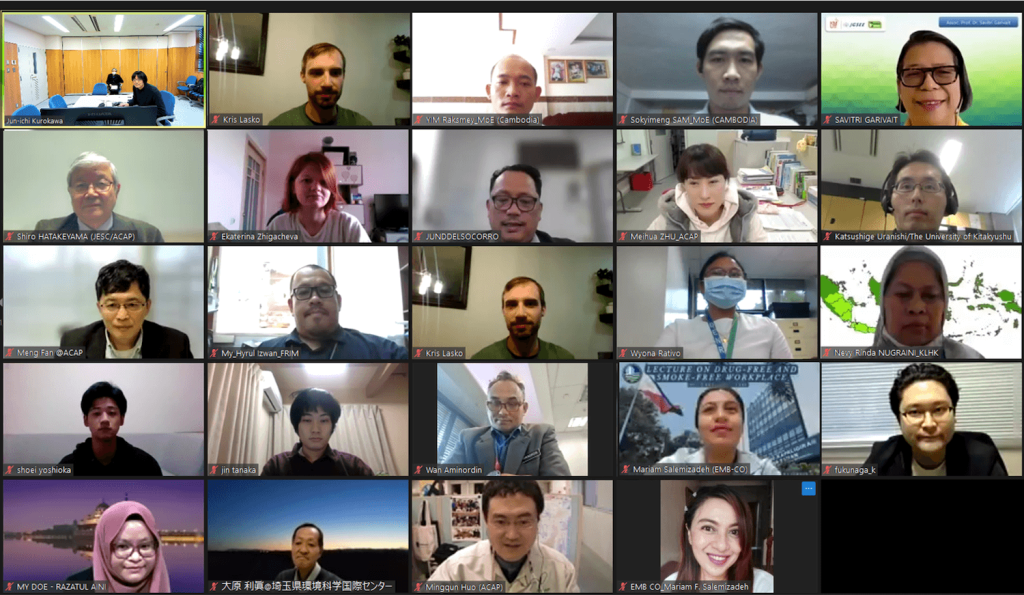The EANET Emission Inventory Webinar Workshop on Open Biomass Burning

8 December 2022 – Niigata, Japan
The Network Center (NC) for the EANET organized the EANET Emission Inventory Webinar Workshop on Open Biomass Burning on 5 December 2022 gathering expert panelists from Japan, Thailand, the USA, and about 50 participants from the EANET countries. Starting with lecture presentations on methodologies to estimate emissions from open biomass burning sources, evaluate uncertainties in estimated emissions, and analyze influences of emissions using air quality models, the Workshop also included, in the second session, presentations from participants on open biomass burning emissions in their respective countries, concluded by discussions on the EANET’s potential role and activities related to open biomass burning.
.
Expert Lectures and Use Cases on Open Biomass-Burning Emission Inventories from Asia and Beyond

Dr. Savitri Garivait from the Joint Graduate School of Energy and Environment, Centre of Excellence on Energy Technology and Environment, King Mongkut’s University of Technology Thonburi, Thailand, presented a comprehensive lecture introducing basic knowledge and information related to open biomass burning emissions. First, Dr. Savitri introduced various types of open biomass burning, namely, forest fires, agricultural waste burning, and solid waste burning. Then, she presented methodologies to estimate emissions from open biomass burning such as basic equations, how to collect activity data as well as information necessary for spatial distribution and temporal variation, and selection of emission factors. To produce activity data, Dr. Savitri emphasized the importance of questionnaire surveys on local and specific data, in order to reduce uncertainties. She finally presented detailed case studies on the evaluation of the contribution of emissions from open biomass burning to the overall emissions and air pollution in Thailand and the Bangkok Metropolitan Region.
Dr. Kristofer Lasko, from the Geospatial Research Laboratory, at the Engineer Research and Development Center (ERDC), United States, provided a lecture focusing on uncertainties of open biomass burning emission inventories, especially on the amount of burned dry matter based on satellite observation data, emission factors for different biomass burning types, and land cover type maps to determine which emission factors to be applied. In his presentation, he explained the major causes of uncertainties based on satellite data including influences of cloud coverage at or near the time of burning, the insufficient spatial resolution to detect agricultural fires, and the limitation in determining actual burned amounts in the field via remote sensing data. For emission factors, Dr. Lasko emphasized the difficulty is not only the uncertainty of each factor but also the variations due to aspects such as variation in burning practices (e.g., piled residue burn vs. open field burn) and moisture. In his presentation, case studies for PM2.5 emission inventories of Viet Nam and the Southeast Asian region were also showcased.
Dr. Katsuhige Uranishi, Department of Life and Environment Engineering, Faculty of Environmental Engineering, the University of Kitakyushu, Japan, provided a lecture about how to evaluate the influences of emissions from open biomass burning on the air quality of neighboring areas using air quality models. First, Dr. Uranishi introduced the basic knowledge and settings of an air quality modeling system by using the Weather Research and Forecasting model and Community Multiscale Air Quality model (WRF/CMAQ) system as an example. He then also presented the Brute-force method, a typical methodology to estimate the contribution of PM2.5 sources using an air quality modeling system. Finally, Dr. Uranishi explained simulation examples for the evaluation of PM2.5 transboundary transport, through case studies in Japan. Because uncertainties are not only in open biomass burning emissions but also in the modeling systems, Dr. Uranishi emphasized that the model performance must be evaluated with observation data prior to estimating air pollution levels or impact. He also recommended reviewing past studies to find appropriate settings of air quality modeling systems to target specific problems.
.
Open Biomass-Burning Emissions Status and Control Measures in East Asia
Participants, in the second session, shared various information about open biomass burning emissions in their respective countries. The presentations covered major sources of open biomass burning emissions and how the emissions are estimated or evaluated in each participant’s country. They also considered how open burning influences air quality and what current control measures are in place in each represented country. These presentations and practical activities were followed by discussions on the EANET’s Project Activities related to open biomass burning emissions including national emission inventories to be organized in 2023.
Participants expressed interest to attend future capacity-building activities related to emission inventories not only from open biomass burning but also from other sources. The monitoring of emission sources to determine local emission factors was also suggested. The NC for the EANET, the organizer of the Workshop will consider the possible future activities to the EANET Project Fund.
.
Useful Resources
- View the Outline and Program
- Download the Webinar Workshop’s presentations
- Development of emission inventory from biomass open burning (forest fires, agricultural burnings, and solid waste burnings) for Thailand and northern ASEAN (presented by Dr. Savitri Garivait)
- Characterizing biomass burning emissions and uncertainty (presented by Dr. Kristofer Lasko)
- Evaluation of PM5 transboundary transport over Northeast Asia caused by biomass burning using air quality model (presented by Dr. Katsushige Uranishi)
- Presentations from participants
.
Photo credits: featured photo of Pom Coong Village, Viet Nam (2020) by Patrick McGregor on Unsplash ; other photos: all rights reserved to EANET.